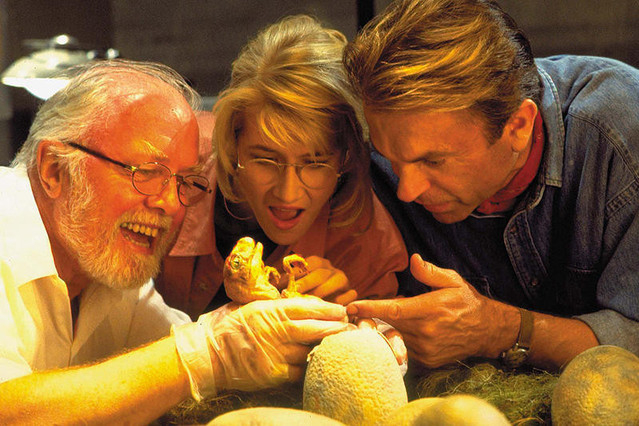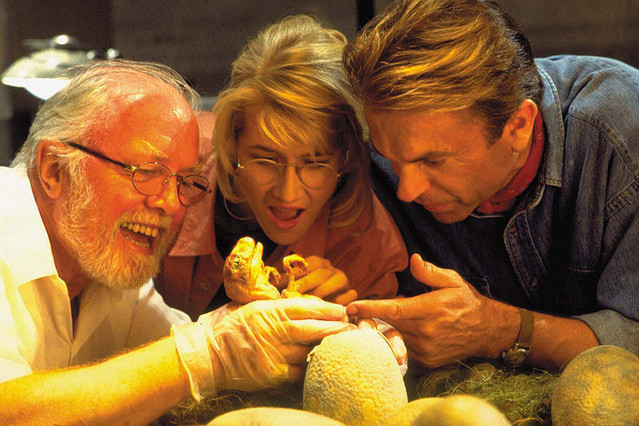ジュラシック・パーク : 映画評論・批評
2020年6月23日更新
1993年7月17日よりロードショー
※「新作映画評論」のページでは、毎週火曜日更新の新作の評論に加え、不定期で「映画.com ALLTIME BEST」に選ばれた旧作の映画評論を掲載しています。
************
単なる「テーマパーク映画」ではない、恐竜スペクタクル映画の傑作
あるシーンが、ビッグバジェットの恐竜スペクタクル映画「ジュラシック・パーク」にリアリティを与えている。
ビジネス界の大物であり「ジュラシック・パーク」の経営者ジョン・ハモンド(リチャード・アッテンボロー)と、古生物学者のグラント博士(サム・ニール)とサトラー博士(ローラ・ダーン)、数学者のマルコム博士(ジェフ・ゴールドブラム)が、生きた牛が檻の中にクレーンで落とされ、姿の見えないヴェロキラプトルに食べ尽くされるのを見るシーンだ。
そのシーンでは、左側から管理者のマルデューンがヴェロキラプトルの問題解決能力についてグラント博士に報告、同時に右側ではパークを運営することへの金銭的不安を払拭したいハモンドが施設の安全性についてサトラーに確認する。交錯するこの2つの会話は、おそらくセットの中で同じブームマイクを通して、同時に収録されている。その会話の背後に響き続けるラプトルの叫び声は、ハモンドに警戒心を覚えさせる。

このシネマヴェリテのような瞬間は、当時のトップクラスのCGIレンダリングや操り人形と同じくらい複雑にデザインされているように感じる。その理由の一つは、スティーブン・スピルバーグ監督が俳優たちに多くの自由を与えているからだ。この不穏な場所に集まっている面々が覚える自然な感覚をそのまま捉え、キャラクターに深みを与える機会として許容している。さらに重要なのは、多方向から同時に聞こえる会話によって、観客に、危険な状況に身を置いていると認識させることだ。
そして「ジュラシック・パーク」は、ゆっくりと観客を捕食する。科学者たちがハモンドの孫と一緒にパークの自動ジープツアーに出発、子どもたちは恐竜が動物園と変わらない人工的な環境の中に隠れているのを見て、がっかりする。だがその後、すべては悪い方向へと向かう。ハリケーンが島に上陸、パークのシステムエンジニアがシステムをハッキングし、恐竜のDNAを盗んで逃げようとする。
その時、私たちは凶悪な恐竜の姿を初めて目の当たりにすることになる。最初のT-Rexは、雷のストロボライトに照らされ、檻を破って現れた。本部に戻ると、リドリー・スコットの「エイリアン」のように暗い廊下から恐竜が飛び出してくる。
マーティン・スコセッシは最近、ハリウッドの大作映画はもう映画ではなく、単なる遊園地のアトラクションだと苦言を呈したが、「ジュラシック・パーク」は、そうした「テーマパーク映画」を応援する側なのかもしれない。しっかりしがみついて!
※英語で書かれた原稿を、DeepL翻訳で日本語訳し、編集部で校正したものです。
[原文]
A Virtual Effects Thrill Ride, but Also Masterful Cinema
There’s a brief take in Jurassic Park that puts real-life breathing room into the big-budget blockbuster dinosaur spectacle. Business mogul and amusement park operator John Hammond (Richard Attenborough) has just shown paleontologists Grant (Sam Neill) and Sattler (Laura Dern) and mathematician Malcolm (Jeff Goldblum) the velociraptor cage, timely enough for them to watch the unseen beasts eat a live cow dropped in by crane. Wary of the ramifications of resurrecting the old world’s masters of the food chain, Grant introduces himself to the park’s game warden, Muldoon, who has just entered the scene. On the left, Muldoon explains to Grant his observations on the raptors’ problem-solving intelligence. On the right, Hammond, who is financially eager to sweep away any anxiety about running a dinosaur kingdom, affirms Sattler of the facility’s safety. Both conversations run at the same time, perhaps through the same boom mic on set. The shriek of a feasting raptor has Hammond tune into the cautionary conversation at his hands.
This cinema-verite moment feels as complexly designed as the top-class CGI rendering and puppeteering of its time. One reason is because director Stephen Spielberg offers a lot of confidence in his actors; he allows this natural group interaction as an opportunity for the characters to develop and hold their footing in this ominous place. More importantly, the multi-directional dialogue has the viewer lean in so that they can install themselves in the danger.
Jurassic Park takes its time to prey on its audience. When the scientists ride with Hammond’s grandkids in the amusement park’s automated jeep tour safari, they are disappointed to find the dinosaurs hide in their manmade habitats, no different from one might find at zoo exhibition. Then everything else goes completely wrong—a seasonal hurricane has gone off course to the park’s island, and the park’s system engineer has bugged everything to run off with stolen dinosaur DNA. That’s when we get to see the dinosaurs. The first T-Rex appears in horrific fashion, broken from its cage under a rainstorm strobe light. Back in the headquarters, raptors pop out from dark sheet metal corridors like Ridley Scott’s Alien. Martin Scorsese famously complained this year that Hollywood blockbusters aren’t films anymore, just mere thrill rides. Jurassic Park may just be the “film” of a theme park ride gone wrong that emboldened that model. Hold on to your butts.






